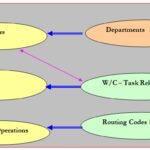Content
The net income (before taxes) of both income statements would still be the same. For example, rent for the building that houses production will remain the same whether a business produces 1 or 1,000 units of products. If they do increase or decrease, it’s usually not due to changes in the level of activity. The income statement is your friend when it comes to your business’s revenue and expenses. In Australia, COVID19 accelerated the click-and-collect service offered by retailers. Customers can order online from most stores and have it ready to pick up in just a few hours (avoiding potentially long wait times for courier or postal delivery).
- If a company uses the latest technology, such as online ordering and delivery, this may help the company attract a new type of customer or create loyalty with longstanding customers.
- The contribution margin income statement is prepared by the management to analyze the impact of the production level on the production costs.
- In fact, we can create a specialised income statement called a contribution margin income statement to determine how changes in sales volume impact the bottom line.
- A variable cost tends to increase as a company scales products and decreases with production.
- That’s why a publicly owned business will still have to prepare a traditional income statement.
- A contribution margin can only be computed by subtracting the variable costs from the revenue.
If you’re using the wrong credit or debit card, it could be costing you serious money. Our experts love this top pick, which features a 0% intro APR for 15 months, The Contribution Margin Income Statement an insane cash back rate of up to 5%, and all somehow for no annual fee. GrowthForce accounting services provided through an alliance with SK CPA, PLLC.
Six of the Elements of a Company’s Financial Report
The CVP relationships of many organisations have become more complex recently because many labour-intensive jobs have been replaced by or supplemented with technology, changing both fixed and variable costs. For those organizations that are still labour-intensive, the labour costs tend to be variable costs, since at higher levels of activity there will be a demand for more labour usage. Also known as a profit and loss statement, a traditional income statement shows the extent to which a company is profitable or not during a given accounting period.
- Getting this calculation right can be time-consuming and relies on consistent reports for fixed and variable earnings.
- Fixed costs remained unchanged; however, as more units are produced and sold, more of the per-unit sales price is available to contribute to the company’s net income.
- This figure helps companies understand how well a product or service is doing financially, and how many units need to be sold to cover the company’s fixed costs and turn a profit.
- During the same period, the fixed expenses paid by the company include rent expenses worth $120,000 and insurance expenses worth $60,000.
- All of these new trends result in changes in the composition of fixed and variable costs for a company and it is this composition that helps determine a company’s profit.
In determining the price and level of production, fixed costs are used in break-even analysis to ensure profitability. It is also represented as amounts, ratios or percentages reveal key information regarding the structure of sales, pricing and commission calculating processes. The contribution income statement, also known as https://kelleysbookkeeping.com/, measures costs based on the functional area or segment of a business. This is different from a traditional income statement, which does not distinguish between fixed- and variable-production and selling costs, and which considers the corporation as a whole rather than each segment individually. The contribution income statement is primarily useful to internal decision makers.
What sort of decisions can be made with CVP analysis?
For example, they can increase advertising to reach more customers, or they can simply increase the costs of their products. However, these strategies could ultimately backfire and result in even lower contribution margins. A key characteristic of the contribution margin is that it remains fixed on a per unit basis irrespective of the number of units manufactured or sold.

They can either make up for those margins by increasing the price or by adjusting payment structure. If this pool company begins paying sales commissions as a percentage of gross profit, rather than gross revenue, they will drastically improve margins and remain profitable. Your Contribution Margin (CM) is the revenue left over after paying all the variable costs – both direct and indirect. Variable indirect costs are the costs that are related to that customer or job, but were not “directly” related to earning that income. You would not have the commission if you didn’t sell the job, so it’s a true variable expense, but it’s not a cost of earning the income.
AccountingTools
The marketing department with the cooperation of research and development department has proposed the production of a new product. Because of limited resources, the new product can only be manufactured if one of the existing products is dropped. To illustrate how this form of income statement can be used, contribution margin income statements for Hicks Manufacturing are shown for the months of April and May.

Since a business typically has variable and fixed expenses, its break-even point cannot be zero. At first glance, you might say that it’s product A due to its high sales price of $200/unit which is significantly higher than product B’s $40/unit ($200 – $160). That’s why a publicly owned business will still have to prepare a traditional income statement. For example, if a production facility can no longer house additional production due to it already operating at maximum capacity, then the business will have to secure another production facility if it plans to produce more units. This situation is called the “step cost situation” wherein a block of expenses must be incurred to accommodate an increase in the level of activity.
Contribution margin income statement
As can be seen from the formula above, computing the break-even point involves the contribution margin, which is something that a contribution margin income statement provides. As such, if a business wants to decrease costs to increase profits, it would usually look into the variable costs that it can reduce. While it is true that you don’t have to prepare a contribution margin income statement, preparing one is still beneficial for your business. A contribution margin can only be computed by subtracting the variable costs from the revenue. Just like the traditional income statement (profit and loss statement), it starts with the business’s revenue.

Using this contribution margin format makes it easy to see the impact of changing sales volume on operating income. Fixed costs remained unchanged; however, as more units are produced and sold, more of the per-unit sales price is available to contribute to the company’s net income. We previously learned the characteristics of fixed and variable costs and introduced the basics of cost behavior. The company will use this “margin” to cover fixed expenses and hopefully to provide a profit.
Thus, only a percentage of the additional revenues go toward paying for the fixed-costs. When calculating an accurate contribution margin, defining your variable costs vs. your fixed costs is essential. However, it should be calculated as direct variable expenses to see gross profit and indirect variable expense to see contribution margin. You need both because if any expenses are in the wrong category on your income statement, then you will not be able to calculate an accurate CB or ratio. For example, there is a company A Ltd which is manufacturing and selling the different products in the market.

